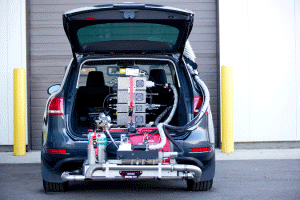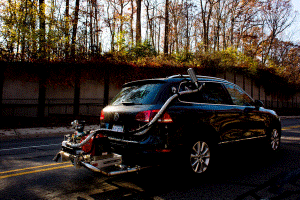By DANNY HAKIM and JAD MOUAWAD
NOV. 8, 2015
NOTICE: THIS WORK MAY BE PROTECTED BY COPYRIGHT
YOU ARE REQUIRED TO READ THE COPYRIGHT NOTICE AT THIS LINK BEFORE YOU READ THE FOLLOWING WORK, THAT IS AVAILABLE SOLELY FOR PRIVATE STUDY, SCHOLARSHIP OR RESEARCH PURSUANT TO 17 U.S.C. SECTION 107 AND 108. IN THE EVENT THAT THE LIBRARY DETERMINES THAT UNLAWFUL COPYING OF THIS WORK HAS OCCURRED, THE LIBRARY HAS THE RIGHT TO BLOCK THE I.P. ADDRESS AT WHICH THE UNLAWFUL COPYING APPEARED TO HAVE OCCURRED. THANK YOU FOR RESPECTING THE RIGHTS OF COPYRIGHT OWNERS.

A Rube Goldberg-type machine is being used as the United States and Canada try to catch emissions cheaters. Credit Laura McDermott for The New York Times
Concerned that cheating on vehicle emissions could be prevalent across the automobile industry, regulators in the United States and Canada are significantly expanding their on-the-road emissions tests to cover all makes and models of diesel cars.
The tests, which come in the wake of Volkswagen’s admission that it installed software on more than 11 million cars to evade emissions standards, are being conducted randomly and in real-world conditions, rather than in traditional laboratory settings, to increase the odds of catching cheaters.
“We are very anxious to find out if there are any other programs out there,” said Christopher Grundler, director of the office of transportation and air quality at the Environmental Protection Agency.
The first tests on brands manufactured by Volkswagen, completed last week, found the cheating software on about 10,000 VW, Audi and Porsche models not previously disclosed by the German manufacturer. Volkswagen disputes the E.P.A.’s claim, saying the software recently uncovered was not intended to thwart emissions testing.

A 2014 Volkswagen Touareg TDI with emissions testing equipment. VW disputes the E.P.A.’s latest findings of illegal software. Credit Laura McDermott for The New York Times
Since then, no other automobile company has been found to have installed so-called defeat software, although it will take several weeks for all makes and models to be tested.
Mr. Grundler declined to describe the tests, except to say they will focus on 2015 and 2016 model year diesel cars. They will also be performed on all new cars that manufacturers seek to certify, he said.
The move by the E.P.A. is a significant expansion of its testing regimen, which previously did road testing for pollutants mainly on large trucks. It also makes road-test spot checks of older cars to ensure that their pollution-control mechanisms are still effective. Tests are also being performed in cooperation with regulators in Canada and California.
But Volkswagen’s scandal has highlighted deficiencies in the existing lab tests in both North America and Europe.
“Regulators must think more like the cheaters,” said Luke Tonachel, a specialist in auto emissions for the Natural Resources Defense Council. “E.P.A. is starting to use new tests that can’t be readily gamed by manufacturers.”
An official with the trade group the Alliance of Automobile Manufacturers said it supported the E.P.A. expansion of road testing.
Europe has been planning its own real-world testing for several years, though those tests will not start until 2017. Other countries, including South Korea, China, India and Mexico, have announced or are considering road tests.
The new and more unpredictable testing represents a sea change from the traditional, highly controlled lab setting where vehicles are put on a treadmill, wired with sensors and run through a standardized and familiar routine.
“Manufacturers have asked us what the test conditions would be, and we’ve told them that they don’t have a need to know,” Mr. Grundler said. “It will be random.”
The road testing could dim the future for diesels, which have higher pollution emissions, making electric and hybrid vehicles more attractive in terms of their effect on the environment.
American regulators believe that road testing is relatively crude and cannot match the precision of lab results at detecting nitrogen oxide and other fine particles and pollutants. Rather, the aim of their road tests is to help validate lab findings by catching cars whose road performance reveals higher emissions readings.
Road testing involves capturing exhaust gases with a Rube Goldberg-type machine the size of a pair of large suitcases that fits in the trunk of most cars, with a few pieces hanging off the back. The technology, which was developed by an E.P.A. engineer, is decades old but until now has been used mostly to test diesel trucks.
To obtain test vehicles, the E.P.A. gets cars directly from manufacturers or sometimes requests loaners from dealers. It also uses rental cars and even reaches out to ordinary drivers to obtain the specific make and model needed for testing. In those cases, the car owner is offered $20 a day and a loaner car in exchange for the use of the vehicle for a couple of weeks. Once the tests are done, the cars are returned cleaned, with a full tank of fuel and an oil change.
Lab testing in Europe is done exclusively by automakers and their contractors, and they are permitted to use preproduction vehicles that will never be sold. The rules also allow them to modify the cars in various ways, for instance, by stripping out back seats to make them lighter, taping up the doors and grilles to make them more aerodynamic and fully charging the battery to put less stress on the engine.
The United States has a more robust lab-testing system. Regulators perform their own lab emissions tests to check manufacturers’ claims. American regulators test preproduction vehicles and those that are already on the road.
As the United States and Europe incorporate road tests, their regulatory regimens are diverging further. Thus far, American regulators are using road tests to catch illegal cheating strategies, known as defeat devices, but they will continue to rely on tests in laboratories.
Europe plans to test in a different way. In addition to lab tests, cars sold in Europe will have to pass separate emissions tests on the road with a new set of maximum emissions of nitrogen oxides.
Europe’s road tests as currently proposed will still not be performed by regulators. They will also continue to involve preproduction vehicles, according to John German, a former E.P.A. official and a senior fellow at the International Council on Clean Transportation, an environmental group that played a pivotal role in uncovering Volkswagen’s cheating.
Mr. German also said the proposed European road test “does not include cold starts” of the engine, which is when most emissions occur.
The European plan, under development since 2011, still faces what could be a contentious fight in the European Parliament, amid criticism that policy makers have watered down earlier proposals.
Automakers say they need to be allowed to exceed Europe’s existing nitrogen oxide standards significantly in the new road tests, which are performed under less predictable conditions than lab tests.
Environmental groups disagree and were angered last week after a review panel appeared to side with automakers.
Under the latest European plan, the road tests, which begin to take effect in 2017, would initially allow automakers to emit more than twice the current European limits on nitrogen oxides. The requirements would become tougher by 2021, when all new cars would be required to emit a level of nitrogen oxides in road tests that is no more than 50 percent above current limits.
European regulators previously sought to allow automakers to exceed the current regulatory limit by less than 20 percent. Environmental groups want automakers to eventually meet the same number on the road that they do in the lab.
Lucia Caudet, a spokeswoman for the European Commission, the European Union’s executive branch, said that since diesel cars, in practice, were already emitting far more nitrogen oxides than permitted by European standards, the new tests would still be a substantial improvement. “We consider this agreement progress,” she said, “although of course ideally we would like to see real driving emission reduced further.”
American regulators have chosen a different approach because the E.P.A. doesn’t think emissions tests conducted on the road are accurate enough to measure to a specific emissions standard. “We think they are much better suited for these screening purposes and looking for defeat devices,” Mr. Grundler said.
The auto industry has publicly embraced the coming European tests, while lobbying to make them less demanding.
At a hearing last month, a member of the British Parliament asked Mike Hawes, the chief executive of the leading auto-industry trade group in Britain, how the industry could restore consumer confidence.
“The fix for this will be the introduction of so-called real-world driving emissions,” Mr. Hawes said.
